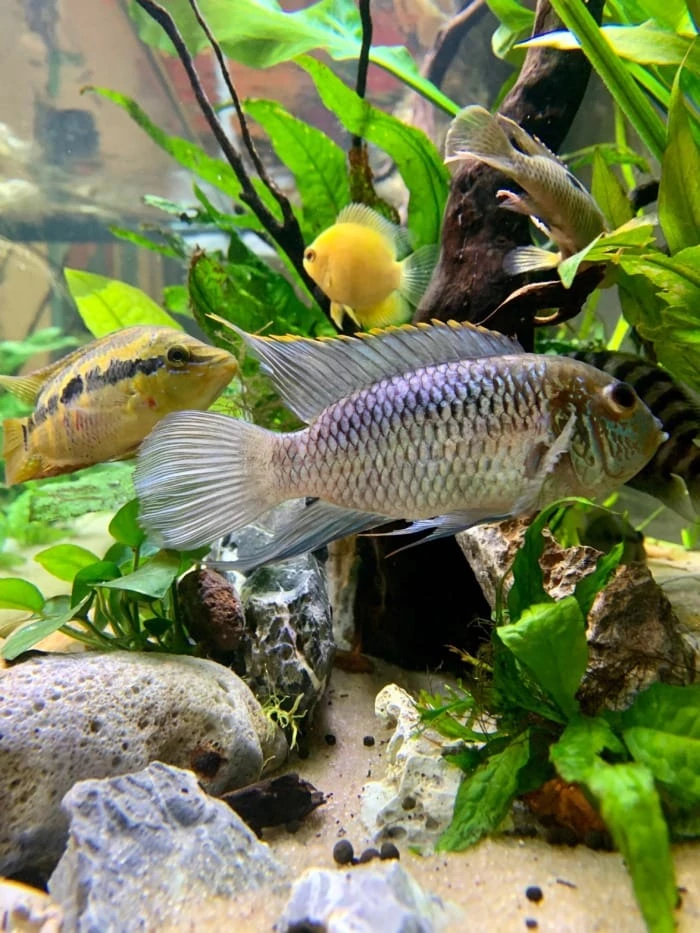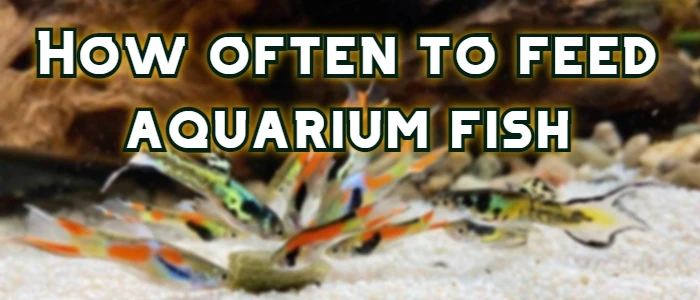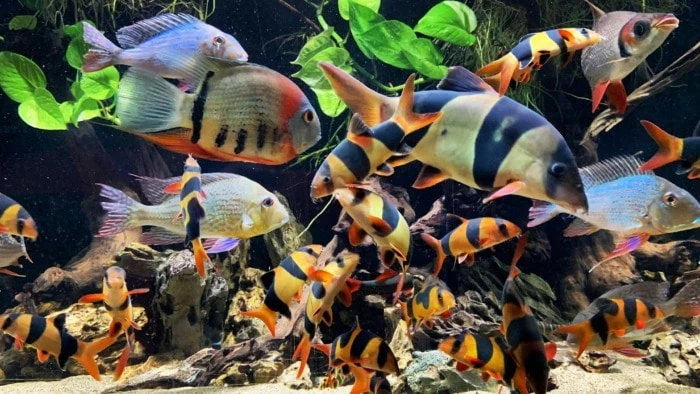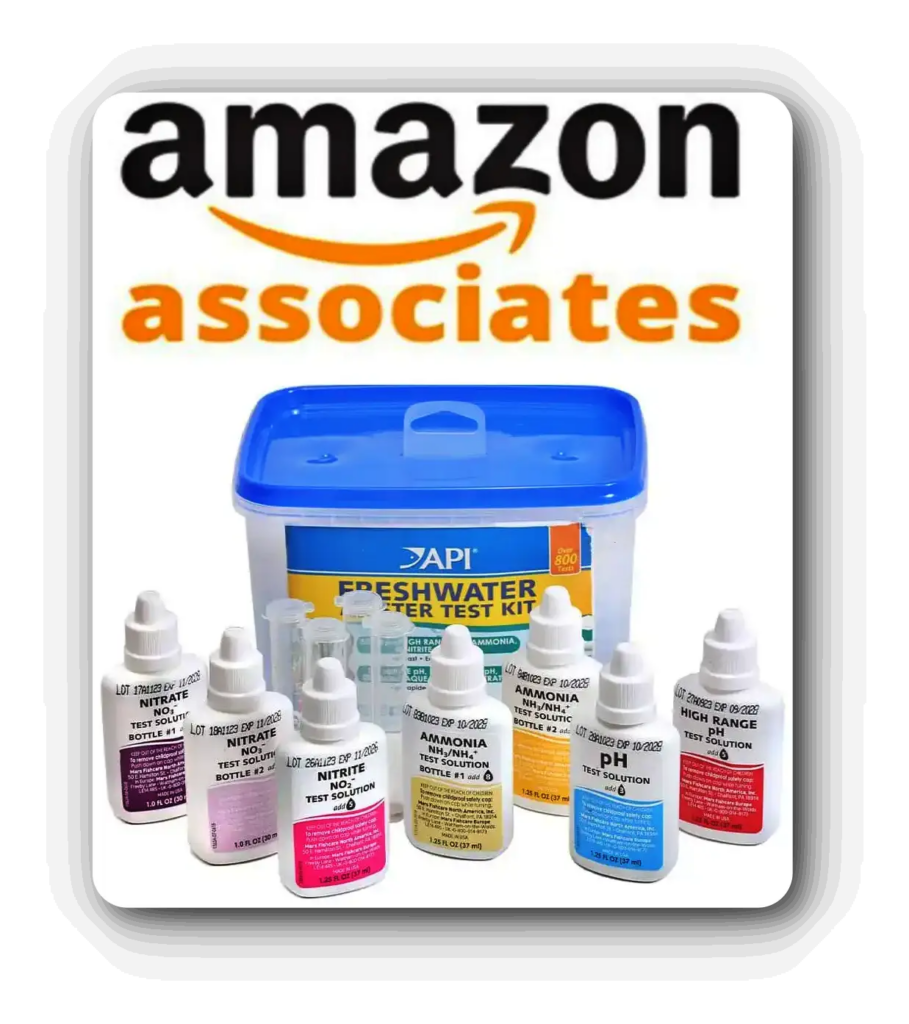The main question most new aquarists often have is how often to feed their fish. Figuring out how often to feed your fish may seem daunting, but you don’t need to worry; I’ve done the research on your behalf. What your fish eats depends on whether they’re omnivores, herbivores, or carnivores. You need to match the nutrition they get in their natural habitat to avoid feeding mistakes.

Overfeeding is one of the main mistakes new aquarists make; the remnant can lead to an unhealthy aquarium, which isn’t good for your fish’s health or the maintenance of the aquarium.
To maintain a healthy aquarium and stay on top of your fish nutrition, you need to know the right food and amount to feed your new friends.
To ensure your fish grows and reproduces, it is vital to get the food they require in both quantity and quality. Feeding your fish right also ensures your aquarium maintenance is straightforward and without stress; there won’t be any unnecessary clogging or spike in the water’s ammonium content.
Understanding Fish Diets
As I mentioned, fishes can be herbivores, carnivores, or omnivores. We’ll be looking at each category and their dietary requirements to ensure you know what they each need in terms of nutrition.
Herbivores: Fishes in this class tend to forage all day because they require more plant materials to meet their nutritional needs—fishes such as the Mbuna Cichlids need proper nutrition to maintain their vibrant color. Most herbivorous fishes are referred to as algae eaters as it is one of their primary sources of nutrition, making them vital in the control of algae growth.
To properly feed a fish, you need to consider what they eat in their natural habitat and familiarize yourself with their dietary needs. Herbivorous fish are used to eating low protein, high fiber foods, due to their undefined stomach. They mainly eat plants, debris, and algae, hence their nickname algae eaters. The food they consume lacks the necessary nutrients, which is why they need to consume a lot to meet their needs.
They search for food all day and stop to eat enough when they find a food source; thankfully, they have a long intestine to digest all their plant-based foods.

A good food source for this class of fish should be rich in immunity-boosting vitamins and contain a balance of nutrients to ensure your little friends swim around for as long as possible.
Herbivorous fish are vital in ensuring the reef system recovers from extreme weather conditions.
Examples of herbivorous fish include plecos, corydoras, damselfish, parrotfish, and rabbitfish.
Omnivores: Most marine fishes are omnivores, meaning they consume both plant and meat-based foods. They can eat most food resources, making them an easy option for new aquarists. However, they may not be as great as the herbivorous and carnivorous fish at eating plants or meat, but because they can eat a variety of meals, they can adapt to any environment.
Try feeding them twice daily, once with commercial foods like pellets and the next meal with meat-based options such as bloodworms and aquatic snails. Make sure whatever you’re feeding them is in bite sizes.
Keep alternating the food they get to prevent them from getting bored while ensuring you meet their dietary requirements. Examples of this class of fish include tigerfish, guppy, and goldfish.
Carnivores: Carnivorous fishes are structured differently than the other classes of fishes, from the structure of their teeth and jaw to the length of their intestines. These parts of their body evolved to match their dietary requirements. Carnivorous fishes never know where their next meal might come from, which is why they are often referred to as opportunistic hunters; they lie in wait for prey to swim by and then use explosive force to catch their prey.
Meat-loving fish can eat a variety of fresh, frozen, or live food. You can feed them shrimps, Scallops, mussels, and fish cuts. Make sure you cut them into bite sizes to avoid bloating, which could lead to your fish swimming upside down; you can read more about this here.
There are several freeze-dried options for carnivorous fish, such as brine shrimp, bloodworms, and plankton. Freeze-dried foods are an easy option that has a long shelf life while maintaining most of their nutritional value. Carnivorous fish should be fed a healthy diet of fat and protein, which can be in the form of pellets or fish pieces. However, live food will always be their most preferred option.
Examples of carnivorous fish include leopard catfish and piranha.
Feeding Schedules by Diet

Feeding your fish twice daily should be sufficient, but it’s best not to give them more food than they can finish within five minutes. Any leftover food should be removed from the aquarium. However, the different classes of fish have varying feeding schedules to match their dietary requirements, lets take a look at each of their needs.
Herbivores
It is common for herbivorous fish to suffer in captivity because they are not being provided with the proper diet to keep them healthy. Most of these fishes are fed lettuce and spinach, which isn’t a good food source for these algae-eaters.
Instead, feed them a mixture of blanched vegetables, including carrots and cucumber. Blanching the vegetables makes it easier for the fish to feed on while reducing vitamin loss, meaning they get the most out of their meal, and it’s easier on their digestive system.
Herbivores are known for foraging throughout the day, so they should be fed more often due to their small stomachs, but in small quantities, as their digestive systems can’t handle large amounts of food at a time. They need to be fed more due to the low-calorie intake they get from their plant-based diet.
Optimally, they should be fed fresh or dried algae; options like spirulina are vital to ensuring your herbivorous fish is healthy. Spirulina improves their immune system, increases growth, and leads to more vibrantly colored fishes.
Omnivores
Omnivorous fish thrive better when fed twice daily; they can survive on a variety of plankton and seaweed mixed with commercial foods like pellets and flake food. Their teeth and digestive tract have evolved to allow them to eat both plant-based and meat-based food options.
They often eat anything from bloodworms to plant matter but ensure they get a balanced diet for optimum health.
Omnivores are the easiest type of fish to feed, which is why they are a great option for community tanks. Even though omnivores will eat plant matter, they are unable to digest some plants and grains. Ensure you research the right type of food or pellets to feed them.
It is important to know the feeding schedule of your fish; if you don’t know when and how much food to feed your fish, it could lead to issues for your fish. For instance, angelfish accepts all types of food but prefers live meals, while a blood parrot will accept all kinds of food.
Carnivores
While omnivorous fishes may do better being fed twice daily, it is better to feed carnivorous fishes once daily due to the slower digestive rate of meat. Carnivorous fish require a high protein and fat diet to improve health and deal with adverse environmental conditions.
Live food is their most preferred option; bloodworms, mosquito larvae, whiptail larvae, and adult brine shrimps are among their favorites.
Some aquarists swear by fasting; it has been shown to improve the digestive system of fish, especially if they’ve been overfed or simply need a cleanse. Fasting your fish for a day or two after a hefty meal can be beneficial to your fish. Fasting benefits your fish in diverse ways, including avoiding bloat and ammonia spikes in the tank.
Factors Affecting Feeding Frequency
When keeping fish in an aquarium, there are factors you should take into consideration to ensure you are caring for them properly, especially when it comes to feeding. Factors like temperature changes can greatly affect the feeding pattern of your fish.
Warm water temperatures increase their metabolism, which means they’ll get hungry faster, which could force you to feed them more food than usual.
When a fish’s metabolism increases, their need for oxygen increases, which in turn affects their feeding and digestive habits. This could affect their growth rate, which isn’t ideal; temperature plays a huge role in the development of fish.
The frequency at which you feed your fish depends on the fish species; most fish take 16 – 24 hours to fully digest their food, so feeding them once a day might be sufficient. However, some owners prefer to feed their fish light meals twice daily. Whichever method you choose, ensure the feedings are small and easy to digest.
Regarding nocturnal fish, such as some catfish, timing is important, so it’s best to feed them right before bed at night. If you have a combination of different species in your tank, you’ll need to consider each species’ dietary needs and find meals to meet each need.
A quick way to know the right portion size to feed your fish is by checking the roundness of their belly from the side and above; you’ll be able to gauge the obesity level of your fish and feed accordingly. It may be hard to discern the roundness with naturally round fishes such as balloon mollies, but you can find reference pictures online to compare.
Another way to avoid overfeeding or underfeeding your fish is by getting specialized feeders that release food at specific times throughout the day. Aquarists often use them when they’re away from home and can’t keep up with feeding, but they can be used to correctly dispense the right amount of food. This ensures your little buddies have a maintained feeding schedule.
How Much To Feed

Most aquarists swear by the general guidelines of only feeding your fish what they can consume within three minutes, but it varies from fish to fish. Some fish are fast eaters, while others take their time to consume their food, such as Bettas. If, after observation, you notice your fish is consuming its food in a shorter time and seem to want more, then you may have to increase the quantity.
If your healthy fish seems to eat less, reducing the food by half may be best. Remember that it’s better to underfeed your fish than overfeed. Underfeeding has fewer consequences compared to the overfeeding dangers you’ll have to deal with.
Portion control is vital in avoiding overfeeding and ensuring your fish stays healthy.
Best Feeding Times

Knowing the natural rhythms of the different fishes in your aquarium will allow you to feed them properly. Most fishes can be classified into diurnal (daytime) and nocturnal feeders (night-time). Diurnal Fishes are mostly active during the day and often show feeding behaviors during daylight. Most freshwater species, such as tilapia and carp, belong to this group.
On the other hand, nocturnal fish are mostly active at night and often prefer to feed in the evening or early in the morning. Certain reef fish and catfish belong to this group.
Aligning feeding with the natural rhythm of your fish leads to benefits such as:
Lower stress levels: Ensuring your fish is fed during their natural peak hours reduces the stress levels related to handling and feeding cycles. If your fish is less stressed, it’ll remain healthy.
Optimal growth rate: Feeding fish during their active period leads to improved digestion, thereby promoting growth.
Feeding behavior: Establishing regular feeding patterns by following the natural rhythm of your fish leads to improved feeding behavior.
Feeding response: Fishes are more likely to respond to feeding signals when they are fed during peak activity time.
Night and day have the largest effect on fish behavior. The cycle of behavioral changes your fish goes through indicates their circadian rhythm; observing this rhythm can help you properly care for your fish.
Nocturnal fishes are mostly dormant during the day but are more active at night, which is why they are best suited to being fed at night. Feeding your fish according to a light schedule ensures you mimic their natural habitat, leading to a healthy and happy aquatic friend.
New Fish And Feeding Issues
When introducing a new fish into an aquarium, the stress level of the fish may increase. It may also develop feeding issues that will require special attention. During the acclimation period, new fish will experience high stress levels, which can affect their feeding behavior. They may reject food and become hesitant to eat until they adjust to their new surroundings. Bettas are known to exhibit this type of behavior.
Gradually introducing your new friend can minimize stress. Quarantining new fish before placing them in the aquarium will allow you to closely monitor and care for your friend. Fish under stressful conditions eat less, leading to a slow growth rate.
However, if your fish doesn’t adjust within a few days, you may need appetite stimulants to encourage your new friend to eat. Before opting for medications such as Seachem Entice, you can try stimulating your fish by feeding it live meals.
Dangers of Overfeeding and Underfeeding

If you overfeed your fish, you may not notice at first, but your overfed fish could develop a fatty liver disease. If your fish’s belly is bloated and it’s refusing food while producing a lot of poop, then that’s an obvious sign of overfeeding.
Overfeeding also affects the overall health of the tank; piles of uneaten food can cause ammonia spikes and an increase in nitrate levels, which will threaten the life of the entire aquarium system.
The leftover food will also lead to algae blooms or even a spike in worm populations; you don’t want these worms swimming about; read more about the type of white worms found in aquariums. Overfeeding generally leads to an increase in diseases such as constipation and fungal and bacterial infections due to terrible water conditions.
Clean out the tank, use a water test kit to ensure the aquarium’s water parameters are safe, and put your fish on a fast to prevent the issue from escalating.

Underfeeding, on the other hand, leads to malnutrition, leading to compromised immunity among your fish population.
This is mostly common among herbivores and omnivores who require constant feeding to meet their dietary needs.
Conclusion
Determining how often to feed aquarium fish is not rocket science, but it requires your attention to avoid overfeeding or underfeeding.
You need to perform research to better understand the dietary needs of the species of fish in your aquarium.
Responsible fishkeeping entails mimicking your fish’s ideal diet in the wild, observing their feeding behaviors, and adjusting accordingly to ensure your fish’s long-term health.
No one wants their beloved pet to fall sick or die due to negligence, so be a good fish parent and ensure your babies are well cared for.


